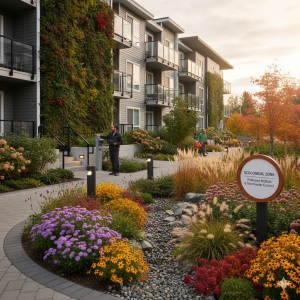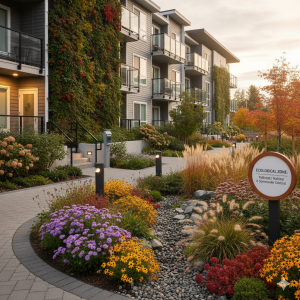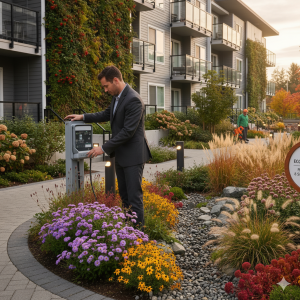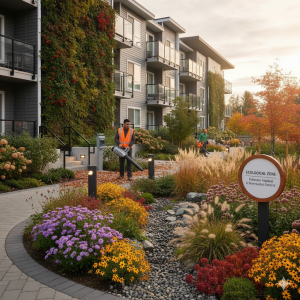Q: What are the biggest fall 2025 landscaping trends in Victoria, BC?
A: Property managers are focusing on water-smart irrigation, climate-resilient planting, stormwater control, safety lighting, and battery-powered maintenance. These updates lower costs, reduce risk, and improve tenant experience.
Planting & Design
Q: What should we plant in fall to reduce costs and survive BC’s climate?
A: Choose drought-tolerant perennials and BC natives. Examples: asters, sedum, rudbeckia, ornamental grasses, kinnikinnick, salal, huckleberry, and vine maple. These plants cut water use, handle storms better, and support pollinators.
Q: How can we make entrances look good through fall and winter?
A: Prioritize texture and structure over short-lived flowers. Use grasses, evergreen shrubs, and seedheads for year-round interest. Add small seasonal highlights (like pumpkins or mums) as accents only.
Q: Are green walls or vertical accents practical in fall?
A: Yes. Cold-tolerant panels, evergreen climbers, and modular planters provide visual interest using foliage contrast and berries instead of blooms.
Irrigation & Stormwater
Q: What’s the smartest irrigation step to take this fall?
A: Install rain-sensing or weather-based controllers, and switch narrow beds to drip irrigation. Do a fall irrigation audit to find leaks, cap unused heads, and tune runtimes.
Q: How do we handle heavy fall rains?
A: Upgrade swales, rain gardens, and permeable hardscapes. Replant with sedges, rushes, and dogwood. Maintain by clearing leaves, checking catch basins, and resetting mulch.
Maintenance & Equipment
Q: How can we reduce noise during leaf cleanup?
A: Use battery-powered blowers and mowers. They’re quieter for offices, schools, and hospitals, while reducing emissions and meeting ESG goals.
Q: What’s a smart way to manage leaves without high costs?
A: Mulch-mow leaves into turf, clear hard surfaces first for safety, and compost or chip excess leaves on-site for soil health.
Safety & Tenant Experience
Q: What lighting upgrades matter most in fall?
A: Install warm LED bollards, step lights, and canopy downlights. Add motion sensors and photometric planning to remove dark spots. Clean and re-aim fixtures each fall.
Q: How can biodiversity be added without making a site look messy?
A: Designate back-of-site strips as “neatly natural” zones with meadow mixes, logs, and seedheads. Post signs so tenants understand the ecological purpose.
Tracking & Reporting
Q: What data should property managers collect in fall?
A: Track irrigation water use, leaf/green waste diversion, and noise/emission reductions from electric equipment. Provide before/after photos and simple reports for ESG planning.
IslandEarth can walk your site, set up audits, and deliver a fall action plan that improves safety, appearance, and costs before winter.



